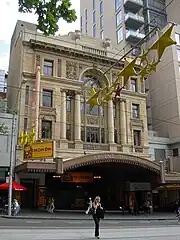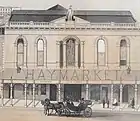37°48′45.8″S 144°58′10.3″E / 37.812722°S 144.969528°E
The East End Theatre District is a precinct within the Melbourne central business district, and is bounded by Spring, Flinders, Swanston and Lonsdale Streets. The district is home to seven major theatres, including the Princess Theatre, Her Majesty's Theatre and the Regent Theatre.[1] These theatres mostly house commercial productions of musicals, plays and other events, in contrast with the Southbank Arts Precinct over the Yarra River which focuses on publicly funded companies.
History
The East End of Melbourne was effectively formed by the Hoddle Grid, with Elizabeth Street the dividing line between east and west. The Hoddle Grid was laid out in 1837, following the founding of the Melbourne settlement in 1835.
Melbourne's first theatre, the Pavilion, was constructed adjacent to the Eagle Tavern on Bourke Street in 1842.[2] The second theatre, the Queen's, was also constructed as part of a pub, however it was, and remains, the only major theatre in Melbourne's CBD built west of Elizabeth Street.[2]
East End theatres
Seven surviving theatres exist within the East End. Other major entertainment venues in the East End Theatre District include live music venues 170 Russell and Max Watt's House of Music, Hoyts Melbourne Central, Palace Kino, Chinatown and ACMI cinemas.
| Theatre | Address | Opened | Capacity | Owner/Operator | First production | Image |
|---|---|---|---|---|---|---|
| Athenaeum Theatre | 188 Collins Street | 1872 | 880 | AT Management | Dear Brutus |  |
| The Capitol | 113 Swanston Street | 1924 | 602 | RMIT |  | |
| Comedy Theatre | 240 Exhibition Street | 1928 | 1003 | Marriner Group | Our Betters |  |
| Forum Melbourne | 154 Flinders Street | 1929 | 2520 | Marriner Group | .jpg.webp) | |
| Her Majesty's Theatre | 219 Exhibition Street | 1886 | 1700 | Hayden Attractions | Bad Lads |  |
| Princess Theatre | 163 Spring Street | 1854 | 1452 | Marriner Group |  | |
| Regent Theatre | 191 Collins Street | 1929 | 2141 | Marriner Group |  |
Former theatres
The East End has been home to over 25 different theatres since 1841. Some of the major former theatres are listed below.
| Theatre | Address | Opened | Closed | Capacity | Owner/Operator | First production | Image |
|---|---|---|---|---|---|---|---|
| Auditorium | 171 Collins Street | 1913 | 1934 | ||||
| Bijou Theatre | 225 Bourke Street | 1876 | 1934 |  | |||
| Gaiety Theatre | 217 Bourke Street | 1890 | 1934 | ||||
| Haymarket Theatre | 133 Bourke Street | 1862 | 1871 |  | |||
| King's Theatre | 131 Russell Street | 1908 | 1976 | ||||
| Olympic Theatre | Corner of Exhibition and Lonsdale streets | 1855 | 1860 | The Lady of Lyons |  | ||
| Palace Theatre | 20 Bourke Street | 1912 | 2014 |  | |||
| Pavilion | Corner of Swanston and Bourke streets | 1841 | 1845 | ||||
| Playbox Theatre | 55 Exhibition Street | 1969 | 1984 | ||||
| Prince of Wales Opera House | 249 Bourke Street | 1872 | 1898 | ||||
| Russell Street Theatre | 19-25 Russell Street | 1955 | 1994 | ||||
| Theatre Royal | 232 Bourke Street | 1855 | 1872 | The School for Scandal |  | ||
| Tivoli Theatre | 249 Bourke Street | 1901 | 1966 |  | |||
| Total House | 170 Russell Street | 1965 | 1978 |
Economic impact
In July 2016, the East End Theatre District was reported to have made an economic contribution of $692 million, and an economic impact of $226 million, to the state of Victoria.[3]
See also
References
- ↑ "Melbourne celebrates the newly named East End Theatre District". Theatre People. Archived from the original on 21 January 2015. Retrieved 16 February 2015.
- 1 2 "Theatre - Entry - eMelbourne - The Encyclopedia of Melbourne Online". Emelbourne.net.au. Retrieved 16 February 2015.
- ↑ "State earns $226 million from musicals boom? | ArtsHub Australia". www.artshub.com.au. Archived from the original on 2016-07-12.
%252C_Forum_Melbourne_--_2019_--_1585.jpg.webp)